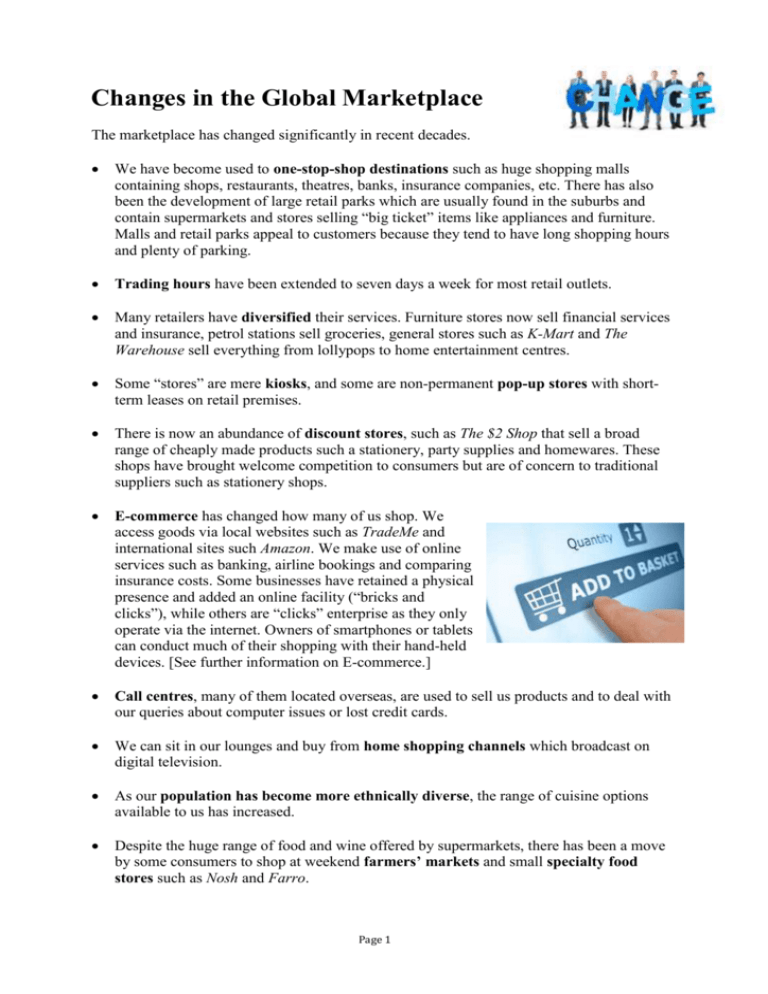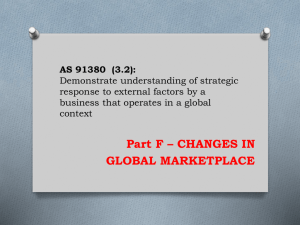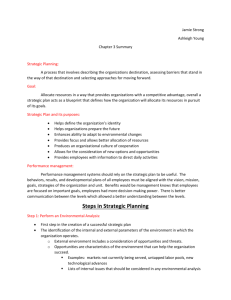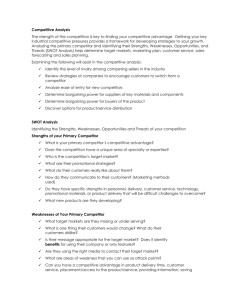3.2 F Changes in Global Market Place
advertisement

Changes in the Global Marketplace The marketplace has changed significantly in recent decades. We have become used to one-stop-shop destinations such as huge shopping malls containing shops, restaurants, theatres, banks, insurance companies, etc. There has also been the development of large retail parks which are usually found in the suburbs and contain supermarkets and stores selling “big ticket” items like appliances and furniture. Malls and retail parks appeal to customers because they tend to have long shopping hours and plenty of parking. Trading hours have been extended to seven days a week for most retail outlets. Many retailers have diversified their services. Furniture stores now sell financial services and insurance, petrol stations sell groceries, general stores such as K-Mart and The Warehouse sell everything from lollypops to home entertainment centres. Some “stores” are mere kiosks, and some are non-permanent pop-up stores with shortterm leases on retail premises. There is now an abundance of discount stores, such as The $2 Shop that sell a broad range of cheaply made products such a stationery, party supplies and homewares. These shops have brought welcome competition to consumers but are of concern to traditional suppliers such as stationery shops. E-commerce has changed how many of us shop. We access goods via local websites such as TradeMe and international sites such Amazon. We make use of online services such as banking, airline bookings and comparing insurance costs. Some businesses have retained a physical presence and added an online facility (“bricks and clicks”), while others are “clicks” enterprise as they only operate via the internet. Owners of smartphones or tablets can conduct much of their shopping with their hand-held devices. [See further information on E-commerce.] Call centres, many of them located overseas, are used to sell us products and to deal with our queries about computer issues or lost credit cards. We can sit in our lounges and buy from home shopping channels which broadcast on digital television. As our population has become more ethnically diverse, the range of cuisine options available to us has increased. Despite the huge range of food and wine offered by supermarkets, there has been a move by some consumers to shop at weekend farmers’ markets and small specialty food stores such as Nosh and Farro. Page 1 How we pay for our shopping has also changed. Cheques have almost disappeared, cash is used in fewer circumstances, but the use of electronic transfer payments has grown enormously. Perhaps the most significant change is that consumers and businesses are now very comfortable operating in a global marketplace. That is, buying internationally known brands, wearing clothing that has been manufactured overseas, and using the world wide web to research, select and pay for goods and services. E-commerce FROM BUSINESS PERSPECTIVE FROM CONSUMERS’ PERSPECTIVE ADVANTAGES access to the global market means the business will be better known a business using e-commerce an operate more competitively increased sales, leading to increased profit it may be possible to dispense with shopfront operation, which represents a saving reduced advertising costs increased sales lead to economies of scale business operates 24/7 ADVANTAGES customers have a huge range of goods to consider from a large number of suppliers they can “shop around” online for the best prices can shop from the comfort of their homes 24/7 DISADVANTAGES being part of the global market increases the level of competition specialists may be required to design and update the website market research needs to be very detailed to ensure the needs of global customers are met packing and distribution of products can be costly and involve long distances not all of the business’s target customers may have access to the internet DISADVANTAGES consumers need to own or have access to computers and have an internet connection it is not easy to assess the quality and suitability of products on the screen returning unwanted goods can be inconvenient a debit card or credit card is required to make internet purchases buying online can pose security risks Page 2 IMPACT OF THE RECESSION An economic recession is defined as six months of declining gross national product (GNP). A recession that lasts for a year would be known as a double-dip recession. A recession has serious consequences for the business sector and the economy as a whole. In a recession: Fewer workers are needed therefore unemployment increases Incomes fall therefore … Demand for goods and services decrease Government tax revenue falls as less income tax and GST is received Firms produce less (therefore have spare capacity) Well-managed businesses may be able to take advantage of a recession. Capital assets such as land may be relatively cheap and firms could invest in these in expectation that the economy will eventually improve. The risk of retrenchment and job losses could encourage improved relations between employees and employers, which could increase efficiency. The recession may cause the business to perform in a leaner, fitter manner by closing unproductive branches or making tough decisions which will actually improve profitability. THE SWOT ANALYSIS TOOL Business owners cannot afford to be complacent about the current success and future viability of their enterprise. A very effective tool for auditing a business and its environment, both internal and external, is a SWOT analysis which helps a business focus and build on its strengths, minimise weaknesses, take the greatest possible advantage of opportunities available, and anticipate any threats the business might face. Internal Analysis The capabilities of the business, its strengths, and its areas of weakness should be examined. Page 3 Strengths: What makes you stand out from your competitors? What do you do well that your competition can’t? What do other businesses see as your strengths? Consider this from both your point of view and that of your clients. Don't be modest. Be realistic. If you are having any difficulty with this, try writing down a list of your characteristics. Some of these will hopefully be strengths! Weaknesses: What do you do badly? What do your customers complain about? What could you improve? Are your reputation and market presence as strong as they could be? What are the areas of struggle for your company? Do you have the staff and technology to provide top-notch customer service? S W Strengths might include The firm’s particular expertise if it operates in a niche market A new innovative product or service The location of the business Top quality products, processes and procedures Considerable customer goodwill Quick to respond to market changes Weaknesses might include: Lack of marketing expertise Undifferentiated products/services, relative to competitors Poor location Damaged reputation Low capital base External Analysis Do an environmental analysis to identify opportunities for the business, and any threats or obstacles to performance. Opportunities: Where are the opportunities for your business or services? What are the trends in your area of specialty? Will changes in demographics, social patterns, or lifestyle changes affect your business? Is your business sector expanding? Are there emerging trends that fit with your company's strengths? Is there a product/service area that others have not yet covered? Threats What obstacles do you face? What is your competition doing? Are your competitors becoming stronger? Are the required specifications for your products or services changing? Do you see other external threats to your company's success? What is happening in the country, in overseas countries you trade in, in the economies? Page 4 O T Opportunities might include a new developing or international market a market vacated by an ineffective competitor new market segments that offer improved profits mergers, joint ventures, or strategic alliances new distribution channels possible could be taking better advantage of social media for promotion Threats might include a new competitor in your market price wars with competitors a competitor with a new, innovative product or service competitors with superior access to channels of distribution recession restricting customers’ discretionary spending uncertainty caused by ongoing earthquakes in Christchurch Page 5




